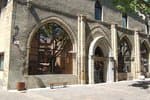Col Girabeau loop
6 points of interest
 History
HistoryCrévoux
Nestled amongst peaks approaching 3,000m, such as the Grand Parpaillon and Pic Saint André, the village of Crévoux occupies a deep valley that has seen the establishment of several hamlets, including La Chalp, which extends over a narrow alluvial terrace. Once at the heart of a major craft industry, with the rise of basket-making and cabinet-making, the village now revolves around its small ski resort, created in 1937, making it one of the oldest in the Hautes-Alpes. History
HistoryCabane des Espagnols
This hut is a memorial to the Spanish refugees who were mobilised in Crévoux to maintain and repair the Parpaillon road, a militarily important road in those troubled times. The Spanish camp at Crévoux was set up in 1939, on the eve of the Second World War and in the twilight of the Spanish Civil War, which saw Franco's victory and the flight of many Spanish republicans to France. Vernacular heritage
Vernacular heritageTraditional houses
Traditional houses in the Alps are often built into the slope. This can be explained by the desire to preserve the most easily cultivated land. The location of dwellings must also consider the proximity of water, while ensuring sufficient distance from mountain hazards (flooding, avalanches, landslides, etc.). These houses are generally arranged on three levels. The ground floor houses the stable for the herd and the farmyard. The heat given off by the animals benefits the whole house as it rises. This floor is sometimes also used to store farm tools. The first floor, accessed by a wooden staircase or balcony, is used for living space. Finally, the second floor is occupied by the barn, which is used to store grain and fodder for a whole year.
. Know-how
Know-howRetaining walls
The retaining walls are made of dry stone. They are called restanques in Provence. In steep areas, they can be used to create farmed terraces by retaining the soil. At the time, their construction enabled generations of farmers to make a living from their land, which became fertile and arable. Today, many researchers and craftsmen are trying to bring back this age-old technique. Fauna
FaunaThe Common Blue
In this small butterfly, the male's upper wings are dark grey, somewhat bluer at the base of the wings, while the female is brown. It is most often seen at higher altitudes, in July and August, in grasslands and meadows. The Arctic blue is a species of northern regions (Scandinavia, Greenland, Siberia, North America) which, in more temperate parts, lives only in the mountains. Pastoralism
PastoralismGrazing
Pastoralism is an extensive management technique. Known as the "Vachaïre", it emerged alongside cattle rearing and milk production. It entailed setting up a community-based herd management system, with the animals grazing every day. And it was the shepherd, "Lou Pastre" in Provençal, who was entrusted with managing the flocks.
Description
- From the car park serving the slopes, drive past La Tanière crêperie then down the narrow road towards the village. Turn right at the first intersection with a wide path. Continue straight ahead on this path at the next three intersections. After a more wooded section, the landscape opens up again and the path leads to the Col de Parpaillon road.
- Turn right onto this road and follow it up several hairpin bends through the Larch trees to the Cabane des Espagnols. Continue on the track that leads to the Col du Parpaillon for quite a few kilometres.
- Take a wide track to the right 200m after a mountain pasture chalet. Once at the top, descend via a technical single track on the left. (Be careful, especially at the top). Make sure you pass to the right of the sheepfold on the descent, then immediately to the left to pick up a single track that winds through the larches. Once you reach the track, turn right to descend it.
- After descending the track for several kilometres, take a path to the right. Cross the bridge and then take the wide balcony path to the hamlet. Turn left onto the road. Follow the road for a few hundred metres, then immediately after a bridge, take a small path on the right to reach the hamlet of Haut Forest.
- Turn right onto the road, which continues along a gravel path. Turn left at the next junction and then straight on for 100m. Turn left again shortly after, then take a small grassy path on the right. Join a wider path and immediately take a small track on the right. Then turn right into the undergrowth on a small path that leads to a track.
- Take a right to go back up the track. Follow the track for several kilometres, first uphill and then downhill. At the junction with another track, turn right towards Crévoux, then right again towards Pont du Réal at the next junction. Turn right again after several hairpin bends and follow the Bouche Clauze forest road to the Pont du Réal.
- Then return via the route taken on the outward journey.
- Departure : Crévoux
- Arrival : Crévoux
- Towns crossed : Crévoux, Les Orres, and Saint-Sauveur
Altimetric profile
Information desks
Tourist office Crévoux
Le pont du plan, la Chalp, 05200 Crévoux
Tourist offices in the ski resort
July and August : From Monday to Saturday : 9:00 - 13.00
From December 22 to March 31 : Everyday except Tuesday and
Thursday, 8.30 - 12.30
Winter holidays : Everyday, 8.30 - 12.30
Tourist office Embrun
Place Général Dosse - BP 49, 05202 Embrun
October to march : Monday to Saturday, 9.00 - 12.30 & 13.30 - 17.00.
April, may, june & september : Monday to Saturday, 9.00 - 12.30 & 14.30 - 18.00
July and August : Monday to Saturday, 9.00 - 19.00. Sundays, 10.00 - 12.30 & 16.00 - 19.00
On French national holidays (except 14th of July and 15th of August) : 9am to 1pm. Closed on the 1st of January, 1st of May, 25th December and 11th November
Closed on Thursdays outside French holidays’ periods
Access and parking
Parking :
Source

Report a problem or an error
If you have found an error on this page or if you have noticed any problems during your hike, please report them to us here:

